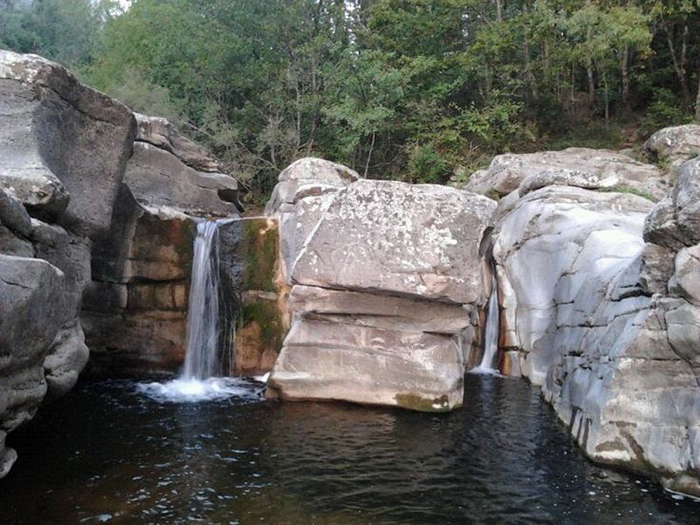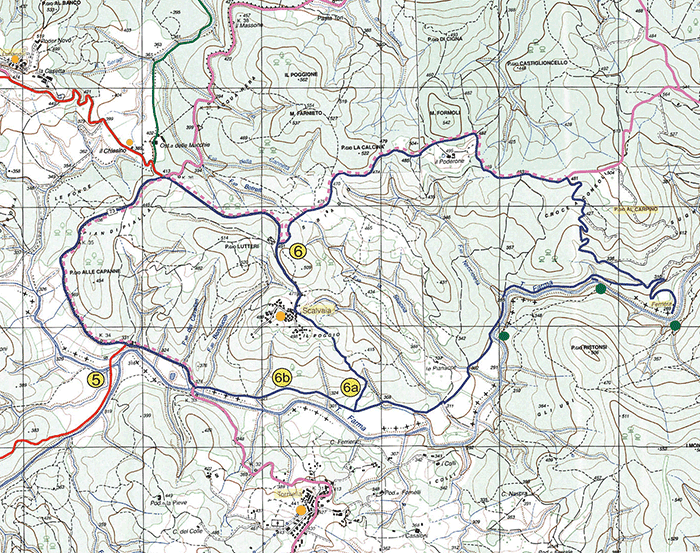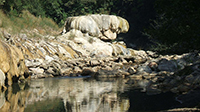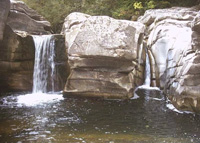 |
|
| I T | I Canaloni del Torrente Farma [Photo: Mago Zichele]
|
|
|
Farma Nature Reserve, situated between Monticiano and Roccastrada, includes the middle stretch of the very beautiful and wild valley where the stream Farma runs, the main tributary of the river Merse, and the upper course of Lanzo, a long stream flowing into the river Ombrone at Paganico. For a while the footpath climbs taking us away momentarily from the river offeringspectacular glimpses of the valley (emergenza naturalistica on the map). After around300m, the path begins its decline taking us back to the river. The nearby river is heardby the sounds of running water. Before the footpath starts to climb, a road to the left,indicated by a red and white sign, takes us, after 100m to the Canaloni. A 150mstretch of river is characterised by a marvellous pools and waterfalls. Here it is alsohard to resist a swim. The rocks that form the Canaloni, are the oldest (about 350 million years old) inTuscany, and are known as the “Poggio al Carpino” formation, the name of the hill immediately to the north of the Canaloni which borders the Farma river on its left. Quartz veins that fill the fractures in the rocks form beautiful paterns. We return onto the original footpath and following alongside the river we cross acouple of ditches, which can be more or less muddy, depending on the season. Afterabout 1 km the footpath passes very near to the river, which forms a large creek (emergenzanaturalistica on the map). Where the grass is longer and lush it is easy to find anatural water spring. After the creek, the footpath takes us away from the river and wereach a clearing bordered by hazelnut trees and finishes becoming a gravely road. Wefollow the road on the flat, passing by paths and tracks on the right leading to the forestand on the left leading to the fields. After around 1 km of road and a little after a smallglimpse of the Torniella village, we have 2 alternatives. 6a) We take a well-hidden path to the right, (the junction is indicated by a post) andruns along the bed of a ditch. The rugged path climbs into an oak forest. We pass by2 roads on the right (in descent) and we follow the footpath, still climbing. The forestis mixed with oak trees, chestnut, evergreen oaks, arbutus strawberries, and heather andpines. We reach a small clearing (450m above sea level) where the footpath becomes aforest track where, after about 400m we reach the hamlet of Scalvaia, after crossing achestnut woods, on the right side of the San Biagio church (8th century). 6b) We continue on the gravely roads until arriving after 2 km to the SS73 Senese-Aretina main road near to the Farma bridge. Taking a right, after about 3 km, we reachthe junction, which takes us to Scalvaia.
|
||
 |
||
Map
|
||
Monticiano and the Farma Nature Reserve |
See I canaloni on Google maps | |
| Monticiano is a very ancient village that lies on the edge of the Tocchi State Reserve and is surrounded by the Nature Reserves of Alto Merse and Farma. Nature is the strength of this area, which includes lush forests where you can walk or ride on horseback surrounded by an extremely rich array of flora and fauna. The river Farma is the most important affluent of the wider river Merse and divides the two provinces of Siena and Grosseto. The Petriolo hot springs are immersed in a beautiful wood where you can relax and swim in the wonderful hot baths of this natural sulphuric water basin. The water emerges at 43°C on the banks of the Farma river. The strong sulphurous smell is due to hydrogen sulphide. This gas, thanks to its sulphuric properties, make Petriolo Thermal Baths rich in mineral salts.
|
|
|
I Canaloni del Torrente Farma
|
|


